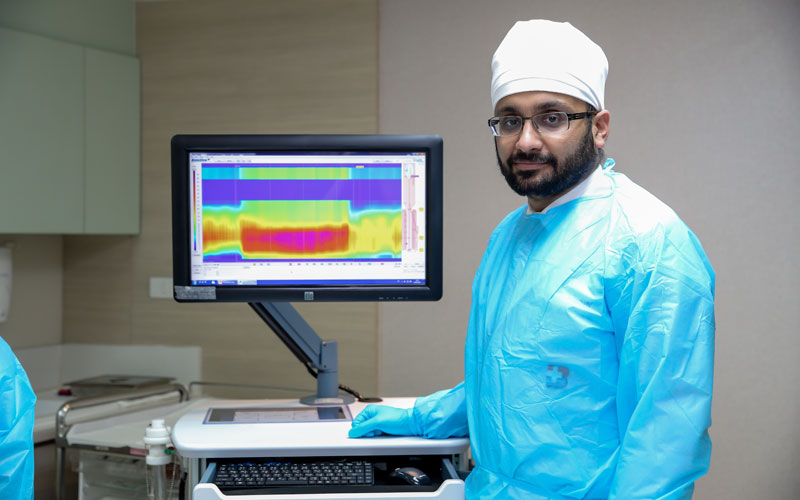
GI Motility Unit at Bangkok Hospital is a specialized and comprehensive clinic particularly for diagnosis and treatment of gastrointestinal motility disorders, both the upper and lower gastrointestinal tracts. With our multidisciplinary team supported by cutting edge technology combined with international standard of care, our scope of services covers these conditions:
Swallowing difficulties (dysphagia)
Gastroesophageal reflux disease (GERD)
Undiagnosed abdominal pain or discomfort
Constipation and fecal incontinence

Swallowing difficulties (dysphagia)
1. High Resolution Esophageal Manometry
Highly sensitive equipment, esophageal manometry is an advanced technique that provides a more precise assessment of esophageal movement. From its high resolution, this equipment is used to thoroughly visualize the esophagus (muscular tube connecting the throat with the stomach) and its swallowing functions by measuring the pressure exerted by esophageal muscles and sphincter muscles during relaxation and contraction while at rest and during swallow. It determines the cause of swallowing difficulties as well as the causes of non-cardiac chest pain or discomfort.
2. High Resolution Esophageal Manometry with Impedance
High-precision equipment, high resolution esophageal manometry with impedance precisely evaluates esophageal motility and the movement mechanism of the lower esophageal sphincter that affect swallowing ability. In addition, incorporated with multiple impedance sensors, this advancement allows the movement of air, liquid and solid foods to be examined. Subsequently, the types residual substances could be correctly identified, ensuring an accurate diagnosis of swallowing difficulties.

Gastroesophageal reflux disease (GERD)
3. pH Monitoring
The esophageal pH monitoring test is performed to continuously measure the pH or amount of acid that flows into the esophagus from the stomach. The acidity evaluation of esophagus is used to diagnose and determine disease severity. This test might be usefully indicated in patients with ill-defined signs and symptoms, patients diagnosed with GERD without complete responses after a full course of previous treatment or GERD patients who might be excessively addicted to antacid and acid-reducing drugs. This diagnostic test can be performed through 2 options;
Catheter-pH monitoring: A measuring tube is inserted through nose into the esophagus to collect acidic signals. Results will be analyzed by computer system.
Wireless capsule Bravo pH monitoring: A small capsule will be inserted via an endoscope to be attached to the esophageal wall. The record of acidic status will be signaled to the external receiver and the esophageal acidity will be precisely computed .
The acidic measurement in the esophagus received from pH monitoring test allows gastroenterologists to better understand the pattern of acid reflux thus further treatment will be managed accordingly.

Undiagnosed abdominal pain or discomfort
4. Hydrogen Breath Test (HBT)
Hydrogen Breath Test (HBT) is safe and easy-to-perform test used as a diagnostic tool for diagnosis of small intestine bacterial overgrowth and carbohydrate mal-absorption such as glucose, lactose and fructose. This test is highly recommended if patients have experienced unidentified abdominal pain, discomfort or tenderness in the stomach after meals. Precise root cause analysis enables patients with abdominal pain to adjust their eating habits in accordance with their specified causes.

Constipation and fecal incontinence
5. High-Resolution Anorectal Manometry
High-resolution anorectal manometry is performed to evaluate causes of constipation and fecal incontinence. It is used to monitor parameters that are needed for regular bowel movements including measurement of the pressures of the anal sphincter muscles, the sensitivity of the rectum to stool movements and the neural reflexes during the resting state of the sphincter. It helps identifying the specific causes and finding the most effective treatments. This test can be further used to diagnose fecal incontinence (inability to control evacuation of the bowel) and Hirschsprung’s disease (an inborn absence of nerves in the wall of the colon). By performing this test, pressure profile of the rectum and anal sphincter muscles could be obtained before intestinal operation is required.
6. 3D High-Definition Anorectal Manometry
3D high-resolution anorectal manometry provides 3D topographic images of pressure along the anal canal. This diagnostic test is used to examine the sensitivity of the rectum to stool movements and the associated correlation between the dynamic movement of anal sphincter muscles and pressure exerted by the rectum.
Images with 3D resolution permit abnormalities to be clearly identified which can greatly be beneficial to patients who have experienced fecal incontinence as well as patients with surgical plan that might affect normal sphincter function.
7. Anorectal Biofeedback Training
Anorectal biofeedback training is a treatment program utilized instrument-based and neuromuscular conditioning techniques to train muscle functions in order to achieve regular bowel movements in patients presented with chronic constipation or fecal incontinence. Through the insertion of an anal probe, this training measures the pressure profile of the rectal sphincter muscles. The muscle functions during bowel movement will be immediately computed on the screen which can greatly help assisting the patients to learn about effective techniques to pass or hold stools healthily.